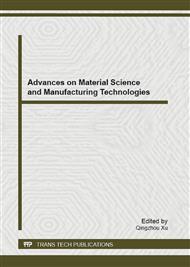[1]
Yongliang Cheng. The progress of the nucleic acid extraction methods. QIAGEN biological.
Google Scholar
[2]
Sonja Berensmeier. Magnetic particles for the separation and purification of nucleic acids, J. Appl Microbiol Biotechnol. 73(2006) 495–504.
DOI: 10.1007/s00253-006-0675-0
Google Scholar
[3]
Hawkins TL, McKernan KJ, Jacotot LB, et al. A magnetic attraction to high-throughput genomics, J. Science. 276(1997) 1887 ~ 1889.
DOI: 10.1126/science.276.5320.1887
Google Scholar
[4]
Stefano R, Vago L. Use of magnetic beads for tissue DNA extraction and IS6110 Mycobacterium tuberculosis PCR, J. Mol Pathol. 52 (1999) 158-160.
DOI: 10.1136/mp.52.3.158
Google Scholar
[5]
Flagstad O, Roed K, Stacy JE, et al.Reliable noninvasive genoty-ping based on excremental PCR of nuclear DNA purified with a magnetic bead protocol, J. M0l Ecol. 8(1999) 879-883.
DOI: 10.1046/j.1365-294x.1999.00623.x
Google Scholar
[6]
Jürgen Oster, Jeffrey Parker, Lotharà Brassard. Polyvinyl-alcohol-based magnetic beads for rapid and efficient separation of specific or unspecific nucleic acid sequences, J. Journal of Magnetism and Magnetic Materials. 225(2001) 145-150.
DOI: 10.1016/s0304-8853(00)01243-9
Google Scholar
[7]
Melanie Störmer, Knut Kleesiek, Jens Dreier. High-Volume Extraction of Nucleic Acids by Magnetic Bead Technology for Ultrasensitive Detection of Bacteria in Blood Components, J. Clinical Chemistry. 53(2007) 104-110.
DOI: 10.1373/clinchem.2006.070987
Google Scholar
[8]
Sorasak Intorasoot, Rujira Srirung, Amornrat Intorasoot, Surachai Ngamratanapaiboon. Application of gelatin-coated magnetic particles for isolation of genomic DNA from bacterial cells, J. Analytical Biochemistry. 386(2009) 291–292.
DOI: 10.1016/j.ab.2008.12.032
Google Scholar
[9]
Cui Ya-li,Li Zheng,Fang Yu.The application of magnetic particles in the Nucleic Acids Research, J. Journal of Northwestern Agricultural University. 28(2000) 80-85.
Google Scholar
[10]
Safarik I, Ptackova L, Safarikova M. Large-scale separation of magnetic bioaffinity adsorbents, J. Biotechnol Lett. 23(2001) 1953–(1956).
Google Scholar
[11]
Franzreb M, Siemann-Herzberg M, Hobley TJ, Thomas ORT. Protein purification using magnetic adsorbent particles, J. Appl Microbiol Biotechnol. 70(2006) 505-516.
DOI: 10.1007/s00253-006-0344-3
Google Scholar
[12]
M. Nagy, P. Otremba, C. Kru¨ger, S. Bergner-Greiner, P. Anders, B. Henske, M. Prinz, L. Roewer. Optimization and validation of a fully automated silica-coated magnetic beads purification technology in forensics, J. Forensic Science International. 152(2005).
DOI: 10.1016/j.forsciint.2005.02.027
Google Scholar
[13]
Centre for Evidence-based Purchasing. Automated nucleic acid extraction systems( 2009).
Google Scholar
[14]
Information on http: /b. jcheng. net/down/47. html.
Google Scholar


